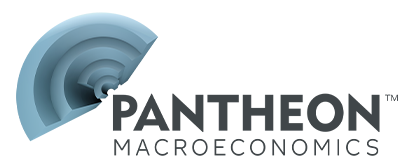US Publications
Below is a list of our US Publications for the last 5 months. If you are looking for reports older than 5 months please email info@pantheonmacro.com, or contact your account rep
Please use the filters on the right to search for a specific date or topic.
Datanotes Weekly Monitor Global Samuel Tombs
Soft September sets for stage for more consumer weakness in Q4.
- Spending rose by 2.7% in Q3, but the stagnation in September likely foreshadows a very weak Q4.
- Real incomes are barely rising, and many near-real time indicators point to a sharp slowdown in growth.
- Q1 likely will be weak too, but bumper tax refunds and a pick-up in hiring will support a Q2 revival.
- The average effective tariff rate is currently just 12%, far short of the near-20% widely expected in spring.
- China imports have dived; more imports than expected from Canada and Mexico are USMCA-compliant.
- The plunge in the Cass Freight Index looks alarming, but it probably is overstating weakness in industry.
Core PCE inflation set to undershoot the FOMC’s forecast in Q4.
- Growth in average hourly earnings is resilient because fewer entry level workers are being hired...
- ...Rising unemployment, the low quits rate and a wide range of surveys all point to an underlying slowdown.
- The NY Fed’s Williams still sees room to ease policy “...in the near term”, bolstering our December call.
Payrolls flattered by the seasonals; rising unemployment keeps a December easing in play.
- Retailers usually pass on the bulk of any cost increases to consumers, but bank most of any savings.
- Retailers won’t cut prices only to hike them again if the White House reimposes tariffs via other routes.
- The AI stock sell-off is small so far, but a deeper rout would have a tangible impact on GDP growth.
- Comparing November’s UoM survey to its historical range overstates the depth of consumer gloom...
- ...But the massive deterioration in major purchase plans this year is too big to simply brush aside.
- Small businesses are bearing down on wage growth; pay rises of just 3% will be the norm next year.
- Continuing claims have returned to their rising trend; Homebase and Indeed data are also weakening.
- Bloomberg Second Measure and Redbook data point to retail sales losing momentum last month.
- Airline passenger numbers have picked up, but hotel room occupancy is now 2pp lower than a year ago.
- Tariffs continue to lift core goods prices; passthrough is now about two-fifths complete…
- …But core services inflation remains in check and the weakening labor market will drag it lower.
- Higher goods inflation will be fleeting, while falling services inflation will enable the FOMC to ease.
- Regional banks are under renewed scrutiny, oil prices have tumbled, and the shutdown is going long...
- ...So markets are starting to see a meaningful chance of a 50bp easing in December.
- But timely data imply the labor market and GDP growth are holding up; 25bp is still more likely.
- Consumers’ major purchase intentions have fallen sharply, signalling flat spending on durable goods.
- NRF and Redbook data point to a drop in retail sales in September, ending a strong three-month run.
- Most measures of spending on discretionary services have weakened, consistent with a lackluster Q4.
- Households have delevered over the last five years and many have fixed-rate mortgages with low rates.
- Reducing the funds rate to 3% next year merely would stabilize the effective mortgage rate.
- The weakness in the ISM surveys in Q3 probably is understating the economy’s underlying momentum.
Drops in the openings-to-unemployment ratio and quits signals slower wage growth ahead.
Turnaround in consumers’ spending built on shaky foundations.
- Spending numbers up to August point to 3% growth in third quarter consumption...
- ...But that pace looks unsustainable, given the myriad headwinds facing households.
- Real after-tax incomes are flatlining, the saving rate is already low, and balance sheets are more fragile.
Unemployment fears resurge; discretionary spending likely to remain subdued.
- Financial conditions have improved for large firms; the bond refinancing headwind has almost gone...
- ...But the option value of waiting for more information is high; the federal policy outlook is uncertain.
- Small businesses still face tight credit conditions; FDI is costlier; and profits are now being squeezed.
The puzzle of retailers’ margins has just been revised away.
- A 25bp easing this week is highly likely, but the vote probably will be split three ways.
- Committee members are still divided on whether rising inflation or unemployment is the bigger risk...
- ...That discord will rule out clear guidance on future easing, though markets will still price-in a big shift.
